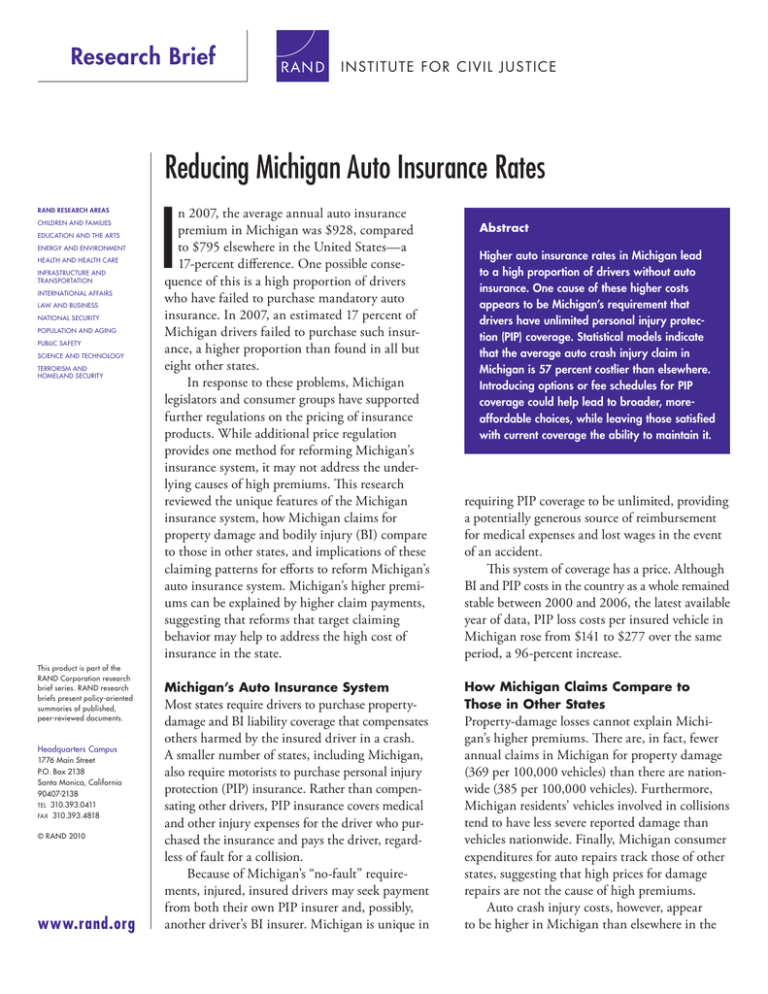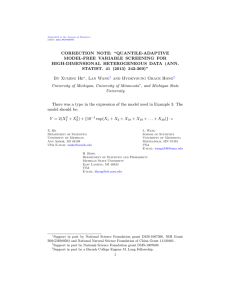I Reducing Michigan Auto Insurance Rates Research Brief
advertisement

Research Brief INSTITUTE FOR CIVIL JUSTICE Reducing Michigan Auto Insurance Rates RAND Research areas Children and Families Education and the Arts Energy and Environment Health and Health Care Infrastructure and Transportation International Affairs Law and Business National Security Population and Aging Public Safety Science and Technology Terrorism and Homeland Security This product is part of the RAND Corporation research brief series. RAND research briefs present policy-oriented summaries of published, peer-reviewed documents. Headquarters Campus 1776 Main Street P.O. Box 2138 Santa Monica, California 90407-2138 Tel 310.393.0411 Fax 310.393.4818 © RAND 2010 www.rand.org I n 2007, the average annual auto insurance premium in Michigan was $928, compared to $795 elsewhere in the United States—a 17-percent difference. One possible consequence of this is a high proportion of drivers who have failed to purchase mandatory auto insurance. In 2007, an estimated 17 percent of Michigan drivers failed to purchase such insurance, a higher proportion than found in all but eight other states. In response to these problems, Michigan legislators and consumer groups have supported further regulations on the pricing of insurance products. While additional price regulation provides one method for reforming Michigan’s insurance system, it may not address the underlying causes of high premiums. This research reviewed the unique features of the Michigan insurance system, how Michigan claims for property damage and bodily injury (BI) compare to those in other states, and implications of these claiming patterns for efforts to reform Michigan’s auto insurance system. Michigan’s higher premiums can be explained by higher claim payments, suggesting that reforms that target claiming behavior may help to address the high cost of insurance in the state. Michigan’s Auto Insurance System Most states require drivers to purchase propertydamage and BI liability coverage that compensates others harmed by the insured driver in a crash. A smaller number of states, including Michigan, also require motorists to purchase personal injury protection (PIP) insurance. Rather than compensating other drivers, PIP insurance covers medical and other injury expenses for the driver who purchased the insurance and pays the driver, regardless of fault for a collision. Because of Michigan’s “no-fault” requirements, injured, insured drivers may seek payment from both their own PIP insurer and, possibly, another driver’s BI insurer. Michigan is unique in Abstract Higher auto insurance rates in Michigan lead to a high proportion of drivers without auto insurance. One cause of these higher costs appears to be Michigan’s requirement that drivers have unlimited personal injury protection (PIP) coverage. Statistical models indicate that the average auto crash injury claim in Michigan is 57 percent costlier than elsewhere. Introducing options or fee schedules for PIP coverage could help lead to broader, moreaffordable choices, while leaving those satisfied with current coverage the ability to maintain it. requiring PIP coverage to be unlimited, providing a potentially generous source of reimbursement for medical expenses and lost wages in the event of an accident. This system of coverage has a price. Although BI and PIP costs in the country as a whole remained stable between 2000 and 2006, the latest available year of data, PIP loss costs per insured vehicle in Michigan rose from $141 to $277 over the same period, a 96-percent increase. How Michigan Claims Compare to Those in Other States Property-damage losses cannot explain Michigan’s higher premiums. There are, in fact, fewer annual claims in Michigan for property damage (369 per 100,000 vehicles) than there are nationwide (385 per 100,000 vehicles). Furthermore, Michigan residents’ vehicles involved in collisions tend to have less severe reported damage than vehicles nationwide. Finally, Michigan consumer expenditures for auto repairs track those of other states, suggesting that high prices for damage repairs are not the cause of high premiums. Auto crash injury costs, however, appear to be higher in Michigan than elsewhere in the nation. A statistical model that predicts the expected costs for paying each Michigan claim assuming costs that mimic those elsewhere in the nation found that, while one might expect an average auto insurance claim to result in an injury claim of $12,885, in fact, it resulted in a claim of $20,229, or 57 percent more. Assuming that injury payments account for 30 percent of auto insurance premiums in Michigan (as elsewhere), then injury payments in Michigan that are 57 percent higher than elsewhere would alone result in 17 percent higher premiums. Moreover, while the proportion of claimants who obtain medical treatment in Michigan (92.8 percent) is almost identical to the proportion elsewhere (92.1 percent), Michigan claimants use a different mix of services. In particular, they are 19 percent more likely than claimants elsewhere to claim reimbursement for a hospital visit and 25 percent more likely to claim reimbursement for emergency-room use. They are also more likely to seek reimbursement for X-rays and computed tomography (CT) scans, to purchase durable medical equipment, and to claim reimbursement for lost wages. Policy Implications High insurance premiums can result from poorly functioning markets or more comprehensive coverage that is more expensive. In Michigan, auto crash injury victims and their medical providers appear to take advantage of generous coverage that insurers are required to offer. Without changing incentives to consume care, it may be difficult to achieve long-term reductions in Michigan auto insurance premiums. A number of policy options can address higher claim costs and have been successfully implemented in other states. Some states have introduced fee schedules for medical services covered by PIP insurance. Other possibilities include allowing policyholders to limit their PIP coverage, select a wider range of PIP deductibles, or more easily designate auto insurers as secondary to health or disability insurers in claim handling. Offering consumers broader choices rather than mandating generous but expensive coverage could allow more individuals to obtain affordable but less-comprehensive coverage while permitting those satisfied with the existing system to maintain their current coverage. ■ This research brief describes work done for the RAND Institute for Civil Justice documented in Reducing Auto Insurance Rates: What Can the Data Tell Us? by Paul Heaton, OP-293-ICJ (available at http://www.rand.org/pubs/occasional_papers/OP293/), 2010, 8 pp., $15, ISBN: 978-0-8330-4955-1. The RAND Corporation is a nonprofit research organization providing objective analysis and effective solutions that address the challenges facing the public and private sectors around the world. RAND’s publications do not necessarily reflect the opinions of its research clients and sponsors. R® is a registered trademark. RAND Offices Santa Monica, CA • Washington, DC • Pittsburgh, PA • New Orleans, LA/Jackson, MS • Boston, MA • Doha, QA • Cambridge, UK • Brussels, BE RB-9513-ICJ (2010) THE ARTS CHILD POLICY This PDF document was made available from www.rand.org as a public service of the RAND Corporation. CIVIL JUSTICE EDUCATION ENERGY AND ENVIRONMENT HEALTH AND HEALTH CARE INTERNATIONAL AFFAIRS NATIONAL SECURITY This product is part of the RAND Corporation research brief series. RAND research briefs present policy-oriented summaries of individual published, peerreviewed documents or of a body of published work. POPULATION AND AGING PUBLIC SAFETY SCIENCE AND TECHNOLOGY SUBSTANCE ABUSE TERRORISM AND HOMELAND SECURITY TRANSPORTATION AND INFRASTRUCTURE The RAND Corporation is a nonprofit research organization providing objective analysis and effective solutions that address the challenges facing the public and private sectors around the world. WORKFORCE AND WORKPLACE Support RAND Browse Books & Publications Make a charitable contribution For More Information Visit RAND at www.rand.org Explore the RAND Institute for Civil Justice View document details Limited Electronic Distribution Rights This document and trademark(s) contained herein are protected by law as indicated in a notice appearing later in this work. This electronic representation of RAND intellectual property is provided for non-commercial use only. Unauthorized posting of RAND PDFs to a non-RAND Web site is prohibited. RAND PDFs are protected under copyright law. Permission is required from RAND to reproduce, or reuse in another form, any of our research documents for commercial use. For information on reprint and linking permissions, please see RAND Permissions.




